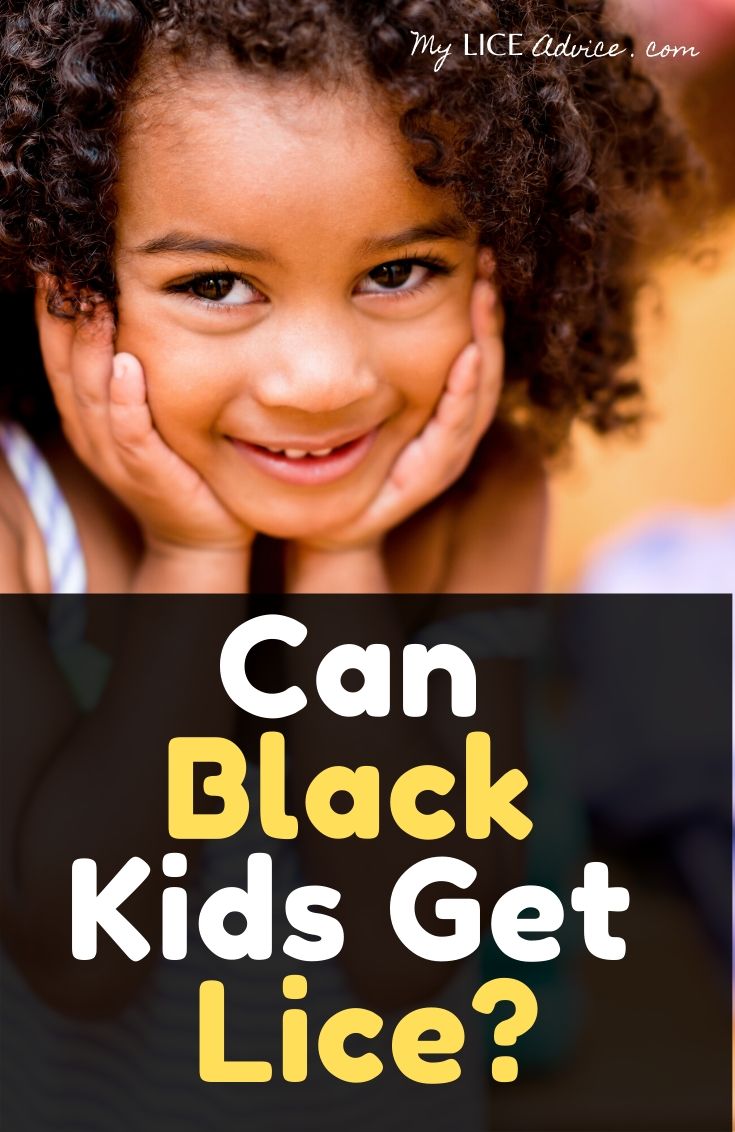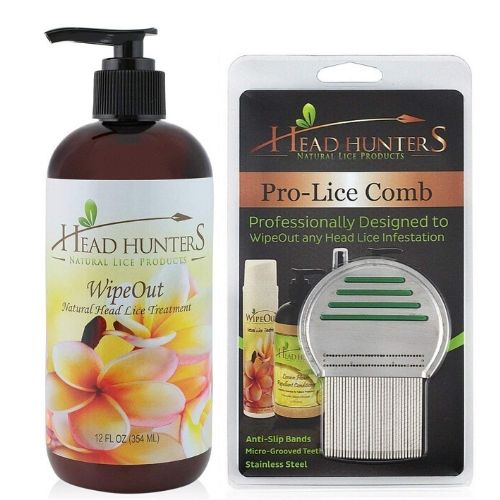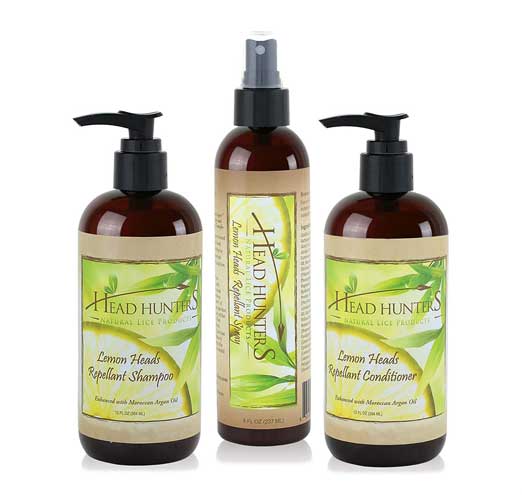Black Children Get Lice Too: Unique Challenges and Treatments
This article explores the prevalence of head lice among Black Americans, theories of why Black individuals are less prone to lice, African-American-specific challenges for head lice, and the best lice treatment options for Black hair.
Question:
Can Black people get lice?
Answer from a Lice Expert:
Yes, anyone can get head lice regardless of their race or ethnicity, but are reported less common among Black Americans than their White neighbors.
Something important to consider is that race, ethnicity, and hair type do not fall into distinct categories, especially today. There are plenty of Black people with straight hair and White people with curly hair. In America, there are more mixed-race individuals than ever before, and as a result, significantly more diversity in hair type.
Those with spiraled or textured hair or locks may find it more challenging to get rid of lice. This article explores some unique challenges and solutions for dealing with lice with different hair types.
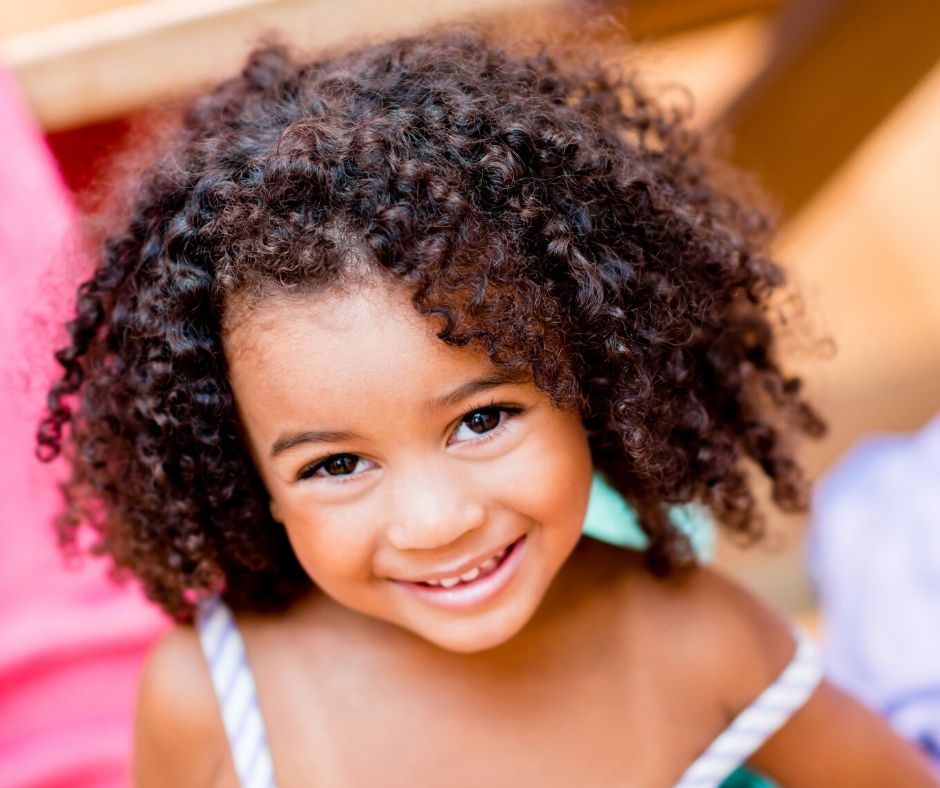
Can Black People Get Lice?
It is a surprising misconception that Black people are immune to head lice. This is unequivocally FALSE. People of all races and nationalities can get any type of lice.
There are three types of lice specific to humans: head lice, body lice, and pubic lice. Most myths about lice and race are associated with head lice, as opposed to body or pubic lice.
Body lice do not appear to have any preference of race. They are most prominent in poverty-stricken areas of the world and almost non-existent in America. Pubic lice is an STD and is equally prominent among all races because it actually prefers course pubic hair as its main habitat.
Head lice only live in human hair and do not spread diseases. Let’s consider a study of two schools in Ghana, a country almost entirely darker-skinned African. This study found that 50% of children had head lice. So long story short, the answer is yes, Black people can absolutely get lice!
Head lice are a widespread problem throughout the United States; it’s estimated that around 12 million people are infested with head lice every year, including Black Americans.
Head lice can be found among all races, but are reported less common among Black Americans than their White neighbors.
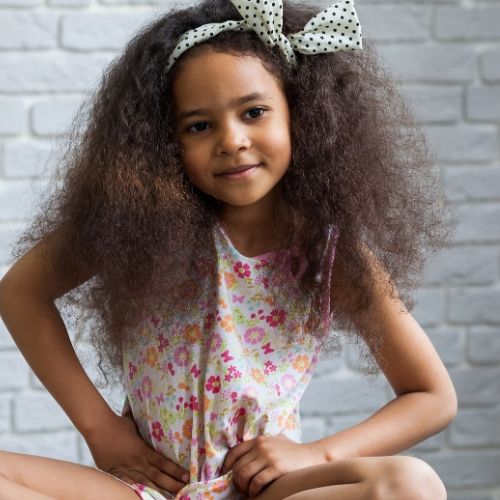
A new strain of head lice has been spreading throughout the United States called super lice. Super lice and regular head lice are virtually the same bugs, except super lice have mutations that make them very difficult to kill and get rid of. These super lice are becoming the “new” strain of head lice and do not discriminate between races any more than regular head lice.
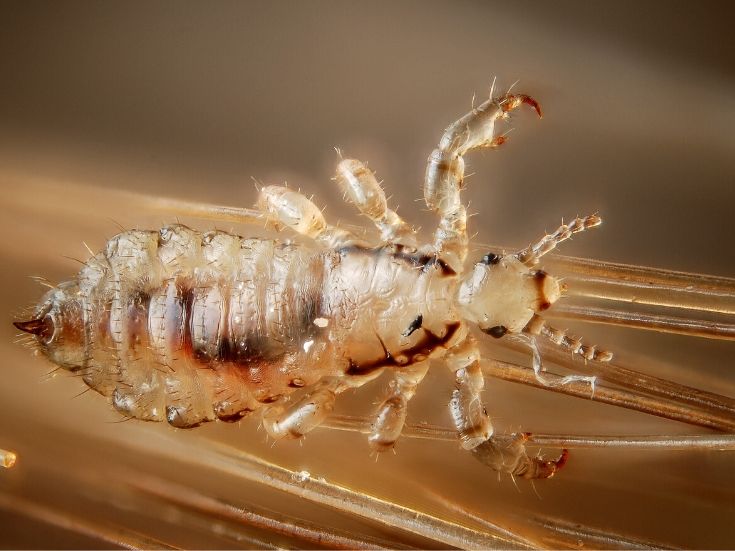
Do Black People Get Lice?
Not only can Black Americans get lice, but they do get head lice. I’ve helped multiple Black children and Black adults in my lice center with extreme head lice infestations. The actual statistics related to how likely it is for Black people in America to get head lice vary and are outdated (30+ years old). Some older studies indicated that White American children were at a 10x greater risk of getting head lice than their Black classmates.
While it is clear that head lice among African American children is lower than Caucasian children, in my expert opinion, head lice are on the rise among African Americans.
This may be a result of a rapid increase in mixed-race individuals or because American lice are adjusting to more hair types. Two countries with similar ethnic populations to the United States (UK and Brazil) have done more recent studies and found little to no difference between the chances of different races (Black or White) getting head lice.
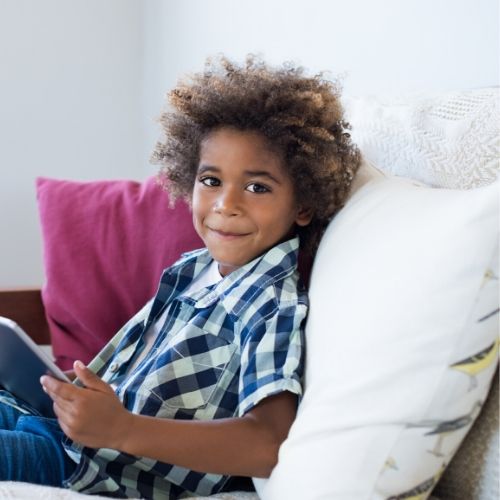
What Does Head Lice Look Like in Black Hair?
Head lice are small bugs that live exclusively in hair. They are the only parasite that infest human hair, so if you find multiple bugs in your children’s hair, it’s likely they have head lice.
Head lice are experts at blending in and they mutate regularly to survive. Adult head lice on Black Americans will likely be dark gray to black, whereas head lice in blond hair will be tan to light brown. Here are photos comparing lice from Black children to lice from White blondes and brunettes.
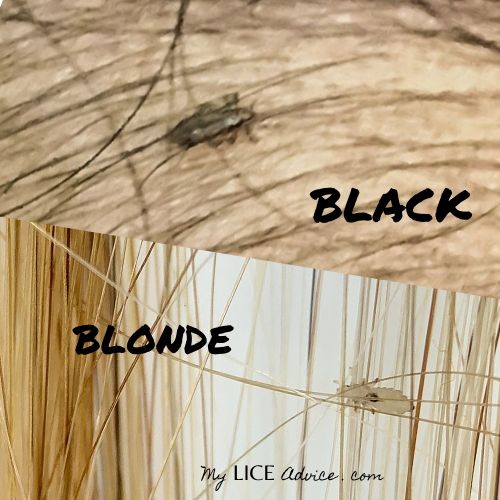
Head lice range from almost invisible at birth to the size of a sesame seed when fully grown. All head lice are clear/translucent when they first hatch, but as they age, head lice change in color. The color of adult head lice typically match the color of hair they are infesting. You would expect a dark-skinned/dark-haired individual to have darker head lice than their blonde neighbor. Here is a comparative photo from two individuals from my lice center:
The defining characteristics of head lice on Black individuals are:
- 6 legs attached to the upper ⅓ of the body, not on the large abdomen
- No wings
- Adult lice are dark gray to opaque black for most Black individuals.
- Nymph (very small, “baby stage” lice) are translucent/clear with a dark stomach.
- Black stomach/intestines often visible through translucent body (larger after feeding)
- Antennae
- Tapered/claw-like legs
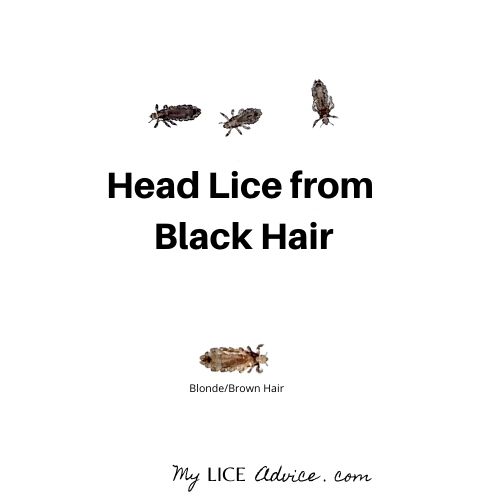
What Do Lice Eggs Look Like in Black Hair?
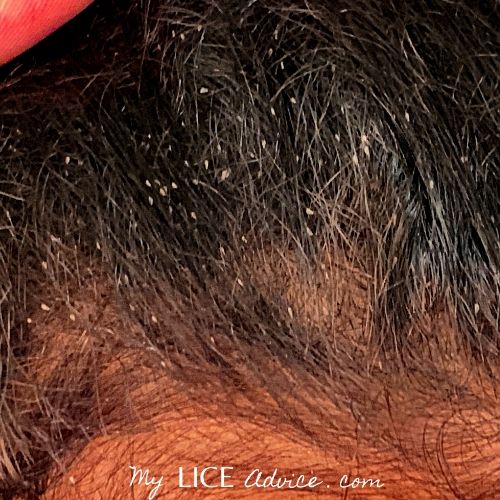
Lice eggs, also called “nits,” are one of the first signs of a head lice infestation. Lice lay between six and ten of these nits in the hair every day, and it adds up quickly. Nits are often mistaken for dandruff or dirt in the hair because they are small and their shiny appearance can make them look white. In black hair, most lice eggs look white and shiny or light brown.
There are 7 main differences between lice and dandruff, the main ones being that nits are glued to the hair strand, they’re tear-drop shaped, and they vary in color from translucent to almost black. The tell-tale sign of lice eggs is that they are stuck to the hair strand, and they will not flick, blow, or brush off.
How Do I Check for Lice In Black Hair?
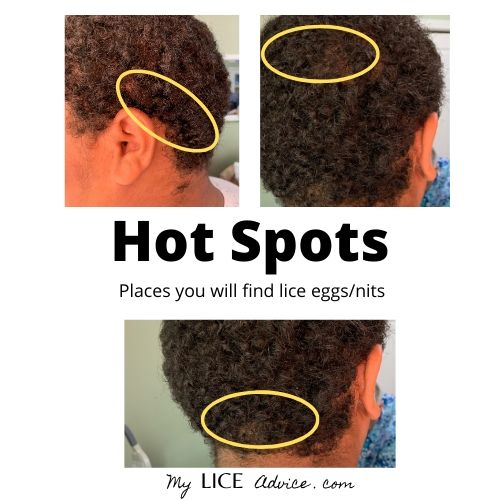
The best places to look for lice eggs are in the “hot spots” of the head: behind the ears, the nape of the neck, and the crown of the head.
Checking for lice eggs in the “hot spots” of the head section by section is the best way to determine whether someone has lice in the early stages. Here’s a link to a full tutorial on how to check for head lice. This tutorial features a Caucasian child, but the principles for checking for lice are the same regardless of race.
Lice-Related Challenges
Super Lice
For years, the go-to lice treatments were over-the-counter pesticides. Unfortunately, many people run to the drug store and grab these same pesticides without knowing that all of the treatments we used thirty years ago are no longer effective against this new strain of lice.
Recent studies show that up to 98% of lice are now resistant to these types of treatments, so it doesn’t matter how large the dosage or how long you leave them on. The treatment only kills the weakest lice, and the strongest super lice continue to breed and multiply.
To actually kill lice, you need to use a product that kills both head lice and super lice. (I have a recommendation for the best treatment for African Americans in the tutorial section of this article.)
This article contains affiliate links, and I earn commission from qualifying purchases, but rest assured I only recommend products that I believe in.
Lice Eggs
Lice eggs from thirty years ago without the super lice mutation could be affected by pesticides, which would prevent them from hatching. Today’s lice eggs are not phased by these treatments, however. They cannot be killed and they will continue to hatch! One option for killing lice eggs is to remove them from the hair using a lice comb or nit-picking.
Once lice eggs are pulled from the hair and tossed, they will not be able to hatch. Lice eggs (including super lice eggs) need to be on the head in order to grow and hatch because they need a very precise climate, a climate only available on your head.
If you focus only on killing lice and not removing eggs, you will not get rid of lice because new lice will continue to hatch from the eggs that weren’t removed.
Here’s what this cycle looks like…
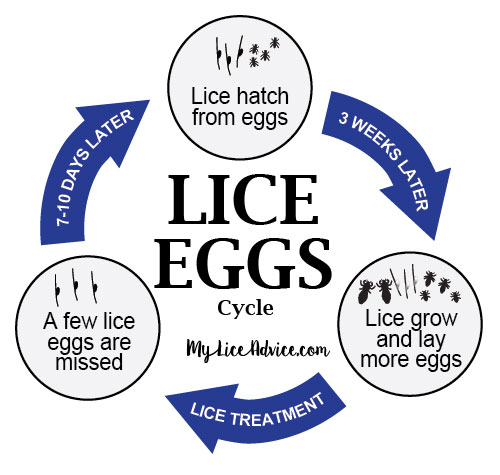
One of the largest barriers for getting rid of lice for those with textured hair is that it may be very challenging to slide a fine-toothed lice comb like this through such spiraled tresses.
For those who are unable to use a lice comb to remove lice eggs, several re-treatments will be necessary since lice eggs will continue to hatch.
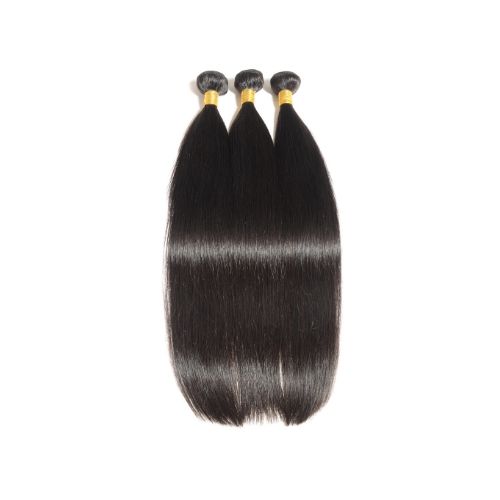
Extensions
Using certain lice treatments on synthetic hair will ruin the extensions, and if they are glued into the hair, some lice treatments will eat away at the extension glue. Lice combs can never be pulled through extensions. The ideal thing to do is remove the extensions for the duration of the lice treatment regime.
If you are dead-set on keeping extensions in, please be sure to read #6 on the Tutorial below, which outlines a repeating treatment regime.
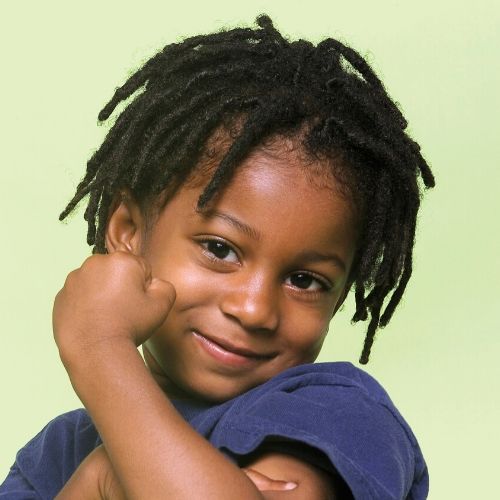
Locks
It is almost impossible to get rid of lice in hair with locks (formerly known as dreadlocks). I have to admit I have never seen it done successfully. The very best solution to getting rid of lice if you have locks is to shave them off. However, if you are desperate to keep yours, please be sure to read #6 on the Tutorial below, which outlines a repeating treatment regime.
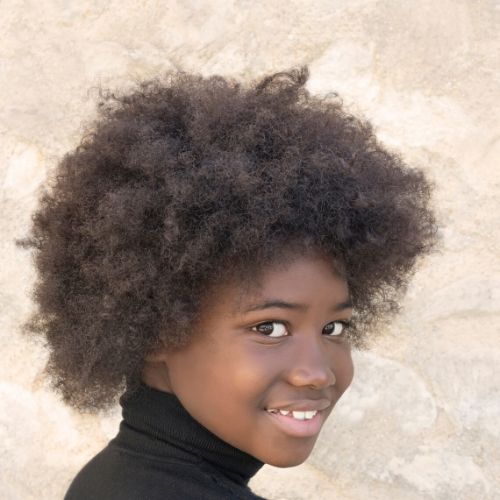
Afro
In my experience, most lice can be tackled in afro-styles if the hair can be divided into sections and the scalp can be exposed in several areas of the head. Flat ironing or blow-drying hair with a brush in small sections can be helpful for this.
On the other hand, if the afro is so thick that it cannot be divided into sections, it may be impossible for lice treatments to penetrate to the scalp in order to kill lice. This is essential because most lice live close to the scalp, so simply coating the upper hair won’t get rid of head lice.
The Best Lice Treatments for Black Hair
There is an appalling lack of lice treatments designed for those with thick, textured hair. Additionally, most lice treatments come in the form of a shampoo, oil, or spray, typically geared toward fine, Caucasian hair. Lice shampoos and sprays usually leave African American hair extremely dry, and what’s more, cannot penetrate to the scalp because the hair is too thick. Oil-based products usually aren’t absorbed well in Black hair, and typically end up dripping off the head instead of staying in the hair and on the scalp.
The best product I have found for Black hair is Head Hunters WipeOut Lice Treatment. WipeOut Lice Treatment has a thick conditioner-like consistency that is significantly better at saturating dense hair. It is applied directly to the scalp in sections, so as long as the hair can be parted, this treatment can be applied. After it is rinsed from the hair, it leaves the hair soft instead of dry, just like a deep conditioner would.
Additionally, this treatment is made from all-natural ingredients that kill head lice (and super lice). Every person I’ve tested this product on in my salon has loved it because it smells amazing (like citrus and flowers), and, like I said earlier, it leaves the hair incredibly soft as opposed to other lice treatments that leave hair dry and difficult to manage.
Regardless of if you believe that you can run a lice comb through your child’s hair, I recommend getting the Head Hunters Pro Lice Kit because it comes with the Nit-Free Terminator Comb. At least giving the comb a try will not hurt anything, and if it does work, you’ll be in for a much easier time!
Removing lice eggs is absolutely the best way to ensure that you can be done with head lice quickly and that they won’t come back. (If you get the kit and it turns out that you can’t use the lice comb, move onto the “without a lice comb” treatment option below.)
For African American hair, I recommend getting the Family Size Head Hunters 32oz bottle because you’ll likely need to use more of the product for dense hair.
The Best Home Remedies For Black Hair
Head Hunter's is an all-natural product, but if you would rather go the home remedy route then these are the best home remedies for those with textured hair. No home remedy kills 100% of lice, even the best home remedies only kill about 80% of lice. And they don't kill lice eggs, so remember that you'll need to do multiple re-treatments. I'd recommend the same regime as the tutorial below, re-treating every 5 days for 3 weeks.
These are the best home remedies for textured hair:
Jamaican Castor Oil is a great lice killer. I don't recommend Jamaican Castor Oil to most people, because if you have light hair it'll give your hair an orangish hue. But if you have dark colored hair then it actually gives your hair a really nice glowr. It's kinda spendy and you'll need to get a lot of it, but it's a great alternative for African-American hair. In the experiments Jamaican Castor Oil killed more lice than coconut oil. And you only have to leave Jamaican Castor Oil in the hair for 30 minutes, whereas with coconut oil it takes 8 hours!
Tutorial: How to Get Rid of Lice in Black Hair
Because of the super lice mutation, which makes both lice and lice eggs very difficult to kill, you have to address both problems. Even the best lice treatments do not kill 100% of lice eggs. Here are the steps you need to take in order to get rid of lice in African American hair, with or without a lice comb:
- Use a super lice treatment or home remedy (as discussed, I recommend Head Hunters WipeOut on dry hair divided into small sections per WipeOut instructions).
- If possible, remove all lice and lice eggs with the Nit-Free Terminator Comb by dividing the hair into small sections.
- Check all family members for head lice.
- Repeat treatment with Head Hunters every 5 days. Today will be day 0, so repeat on days 5, 10, and 15.
- Clean your house using the following principles as a guide (or simply check out our article, Lice Cleaning Checklist to Get Rid of Lice in Your Home)
Think 48 Hours
Focus on cleaning items that have been in contact with the lice-infested individual within the last 48 hours. Lice cannot live longer than 48 hours on household items.
Do Not Use Lice Sprays
Lice sprays do not work on lice. Multiple scientific studies have shown that almost all lice in the US are resistant to the pesticides found in lice sprays.
Vacuum
You can vacuum surfaces, such as couches and mattresses, to suck up lice.
Clean Your Brushes
Soak hair brushes, combs, and hair accessories (such as hairbands, clips, and headbands) used by the person with lice in hot water (135° F or greater) for at least ten minutes. (I do not recommend boiling brushes and combs, however, because they will melt.)
Items in the Dryer
Put items in the dryer for forty minutes on high heat.
Bag Items for 2 Days
Lice can’t live without blood for very long, so anything that could have lice on it will be safe to use again after 48 hours. If an item is something that you cannot run through the dryer, like a favorite stuffed toy or delicate clothing, you can seal it away in a bag for a couple days.
Don’t Forget Car Seats
Vacuum the car seats of anyone who has had lice.
Why Don’t Black Americans Get Lice as Often as Other Races?
There is not one definitive answer as to why head lice in America prefer to infest Caucasians more than African Americans, but there are several theories backed by some science.
Lice Can Grip Caucasian Hair Types Easier
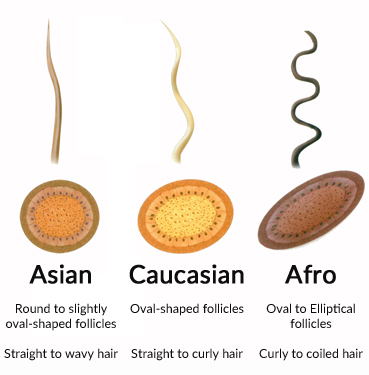
Different races have different shapes and textures to their hair. There are thousands of different hair types and subtypes, and simply it wouldn’t be accurate to say that one race has thick or thin hair and another race has straight or curly hair. However, hair type is commonly divided into three “original” ethnic profiles: Asian, Caucasian, and Black.
In these three categories, Asian hair strands are characterized as straight and round in shape. Caucasian hairs are characterized as straight or wavy and oval in shape. African American hairs are characterized as curly or kinky and flat in shape.
There is ample evidence that head lice have adapted in multiple ways in different countries, so it is likely that they may have adapted to different hair types in different countries as well. As with all species, lice mutate and adapt to best survive their changing world.
It’s likely that most head lice came to America from those that immigrated from Europe with Caucasian-textured hair. Over the decades, American lice have likely adapted to best survive in the hair type, texture, and shape of Caucasians.
On the other hand, in other countries with a high percentage of dark-skinned individuals, head lice have adapted to survive well in that hair type, texture, and shape.
Something important to consider is that race, ethnicity, and hair type do not actually fall into three distinct categories, especially today. There are plenty of Black people with straight hair and White people with curly hair. In America, there are more mixed-race individuals than ever before, and as a result, significantly more diversity in hair type.
Lice Prefer Some Blood Over Others
Lice are attracted to the smell of human blood and like mosquitoes, lice prefer some people's blood over others.
Lice actually smell blood and are drawn to it, like sharks. If they smell desirable blood nearby, they hustle to that other “yummy” head.
One theory is that head lice prefer the smell of more Caucasians’ blood over that of their African American friends. This does not mean that White or Black children are dirtier or cleaner, or smell (to humans) in any way. Lice just love some people more than others.
The best way for any person to hide their blood scent and prevent getting lice is by adding pleasant smells to their hair that repel lice. Many use tea tree shampoo for this purpose, but in my experience, lice prevention requires a bit more than that. Read our article 19 Essential Oils that Repel Lice to create your own lice prevention spray or buy a lice repellent shampoo or spray. (For a list of the best lice repellent shampoos and sprays, you can go to this article where I talk extensively about each brand on the market and which is best.) In my professional opinion, Head Hunters is the best brand for African American hair. Head Hunters Lemon Heads Shampoo, Conditioner, and Spray deep conditions and leaves oils in your hair that’ll have your hair smelling and feeling great.
Use of Oils and Hair Gel
Hair oils like jojoba oil, coconut oil, and castor oils are used frequently by many African Americans. Many believe that the frequent use of these oils is one of the reasons why Black individuals get head lice less often. There may be some truth to this theory.
Lice are excellent "tightrope walkers" of the hair, but if you grease up that rope, it's a lot harder to walk. Each of their little legs has claws specifically designed to cling onto hair strands without falling off. Knowing this, the theory that oiled-up hair can make it difficult for lice to grip makes sense.
This is, of course, difficult to test in a lab experiment. There have, however, been two oils that have been proven to be effective against lice in studies: coconut oil and neem oil.
Hair gel as a lice deterrent has not been studied intensely, but one study showed that both Black children and their Caucasian classmates were less likely to have lice if they used hair gel regularly.
Heat Treatments
Lice die if exposed to high levels of heat (greater than 135° F). Most flat irons get much hotter than that. While it may be true that heat treatments can be a deterrent for head lice, flat irons themselves are not a practical lice treatment. While flat iron treatments may “fry” a few lice, they are generally not effective at getting rid of lice for two reasons: lice move around in your hair, so you are likely to miss them, and lice and nits are so close to your scalp, you would likely burn yourself trying to reach them.
Relaxing/Straightening Treatments
Relaxing treatments are becoming less common now that many African American women are choosing to stick with their natural hair texture. It’s possible, though, that these treatments have deterred or killed lice. Many of the chemicals used for these types of treatments can be quite toxic, so they may be toxic to lice. There are, however, no scientific studies on the subject.
Summing it Up...
If you are a Black American, you are less likely to get head lice, but you are unfortunately and absolutely NOT immune to lice. Head lice affects 12 million people every year, including plenty of Black children.
If you have discovered that you or your child has head lice and you have textured hair, the best treatment out there is Head Hunters Pro Lice Treatment. If you use my tutorial provided above, you’ll have lice out of your life in no time. You’ll also want to check out my tutorial on house cleaning after head lice.
Making your own Natural Lice Prevention Spray or using a lice prevention spray like Head Hunters Lemon Heads Repel is just one way to prevent head lice. If you’re really serious about lice prevention, then check out our article 21 ways to prevent head lice.
All the best,
Theresa, My Lice Advice
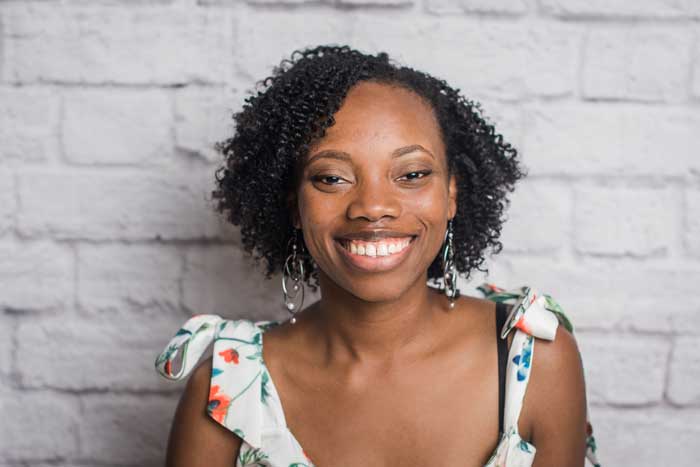
A big thank you to Keyona Grant for collaborating on this article! Keyona helps working moms simplify motherhood and excel in both their work and home life. Check her out at ProfessionalMomma.com where she empowers mothers pursuing their career goals and personal dreams, whatever they may be!
About the Author:
Theresa is a Registered Nurse and lice expert with years of experience curing children of lice. She owns a lice treatment center in the US which is where she perfected the Step-by-Step Video System proven to get rid of lice. She also works with government agencies and schools helping those with the worst head lice cases in America.
Her greatest passion is empowering parents by teaching parents online how to do a professional lice treatment on their child at home. She is the Lice Coach for the My Lice Advice Step-by-Step Video System.

